About the iMean7 conference
More about the conference programme, panels, welcome reception and conference dinner.
Conference venue
iMean7 conference will take place in room 2X112 (base room) within the Bristol Business School at UWE Bristol. Located in the heart of Frenchay Campus, the Bristol Business School building was opened in 2017 and offers an innovative way of studying and working, with new social and learning spaces to allow students, staff and business people to work more closely together, and make valuable new connections.
Registration for iMean7 conference will be in the Atrium space of the Bristol Business School building.
There are accessible toilets with alarms on every floor in the building. Level 2 (ground floor) has an accessible toilet with a shower, wash and dry WC, ceiling track hoist and baby changing facilities. We have a dedicated room to rest and recover with soft seating and a fold-up bed.
Welcome Reception
We hope you will join us for our Drinks Reception at 18:30 on Wednesday 19 June 2024 in the main Conference Venue (the Bristol Business School Atrium). It provides an opportunity for us to welcome you to Bristol and to iMean7.
The reception is sponsored by a range of publishers who will be displaying their books throughout the conference, including (TBC) Benjamins, Bloomsbury, Cambridge University Press, Edinburgh University Press, Elsevier, Multilingual Matters, Oxford University Press, Palgrave/Springer, Routledge/Taylor and Francis and Wiley.
Bristol Business School building
Also known as "X block", the Bristol Business School building is a space that offers an innovative way of studying and working.
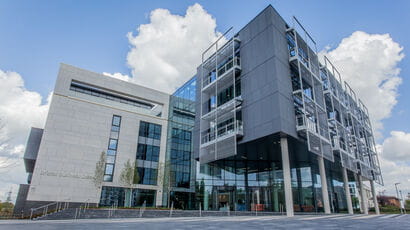
Exterior view
Located in the heart of UWE Bristol Frenchay Campus.
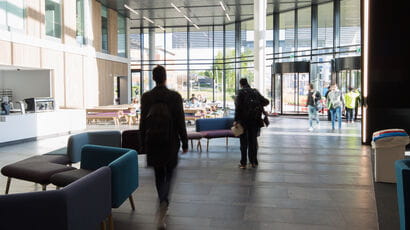
The Atrium
The Atrium Cafe situated within this space serves locally sourced food through a full hot a la carte menu.
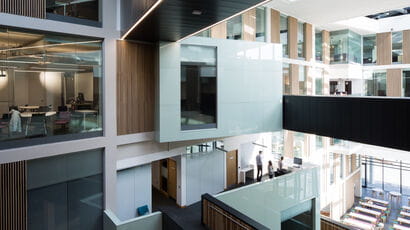
Professional spaces
A 17,200m2 space serving 5,500 students and containing 148 offices over seven floors.
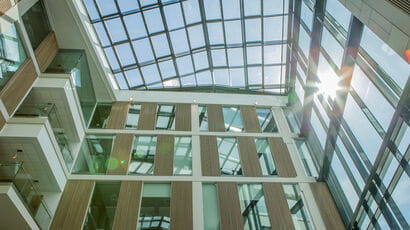
Glass ceiling
The glass atrium roof has two open balconies and one enclosed balcony and windows to offices.
Conference Dinner
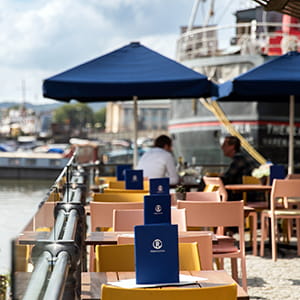
The Conference Dinner will take place at the scenic Riverstation, located on Bristol’s iconic harbourside in the centre of Bristol, on the evening of Thursday 20 June 2024.
You can find out more information such as the conference dinner rate or register/pay for the conference dinner on the iMean7 Registration page.
The photograph on the right has been provided courtesy of Riverstation.
Panels
Find out more about the conference panels below.
Advancing inclusion in the workplace (Convenors: Professor Jo Angouri and Professor Meredith Marra)
Panel abstract coming soon.
Discourse markers and inclusion (Convenor: Dr Kate Beeching)
Language can (be used to) increase or decrease an individual’s or group’s sense of social inclusion. The history of the 21st century thus far shows little evidence of any progress made in the direction of greater equality or social justice. This panel welcomes studies on discourse markers (DMs), modal particles (MPs) and filled pauses (FPs) with a focus on their ability to help interlocutors feel included. Pragmatically, DMs can help oil the wheels of social interaction and thus smooth relations and promote harmony and a sense of inclusion. Sociolinguistically, too, DMs can be indicators, markers or stereotypes of particular social groups and using them can help speakers be included in those groups and possibly be excluded by other groups: young people use like to ‘fit in’, older speakers, parents and educators frequently deplore the ubiquitous use of this DM. Given the contradictory reaction to this very popular DM, language teachers might be forgiven for not knowing whether or how to teach such items. The panel welcomes empirical studies investigating this issue.
The need that speakers feel to be inclusive of their interlocutors is also of interest to language historians. DMs and MPs develop from more propositional lexical items, thus indicating the functional pressure that interactional concerns may have on language structure – at least, in the semantic structure of particular lexemes. Using the term Politeness-Induced Semantic Change (PISC), Beeching (2005) demonstrated how quand même (‘even though, all the same, though’) evolved from a concessive conjunction in the seventeenth century to a hedging mitigator in the 20th . Similarly comme (like) and genre (‘sort’) have developed approximating and hedging uses in some varieties of (Canadian) French.
The panel aims to bring together scholars working on English, French and other languages, with empirical evidence of the ways that DMs enhance inclusion pragmatically or sociolinguistically in everyday spoken interaction but also in health, education and other contexts.
We also welcome historical papers showing how these items’ DM status evolves historically precisely out of a concern for appropriate social interaction and inclusion.
Please contact Dr Kate Beeching (kate.beeching@uwe.ac.uk) with any queries about this panel.
Language, inclusion and the law (Convenor: Dr Kate Steel)
This panel invites studies of language use in relation to forensic and legal contexts, with a focus on how social inclusion is (or is not) reconciled with the legal characteristics of these situations. It is well-established that communication between representatives of the legal system and members of the public involves competing frames (e.g. Agar 1985; Tracy 1997), whereby institutional-legal goals may not align with citizens’ lifeworld needs. At the same time, better relations encourage public confidence in and cooperation with legal processes (e.g. Vallano & Schreiber Compo 2011), thereby underpinning institutional legitimacy. The panel will explore this legal-interpersonal nexus with a focus on how language use increases or hinders social inclusion. In particular, we welcome studies which explore the experiences of marginalised groups in society, when inclusion or exclusion intersects with characteristics such as race, religion, sexual orientation, gender identity and disability.
We aim to bring together a range of empirical studies which investigate spoken, written or multimodal communication within the legal system in any jurisdiction(s). This may include - but is certainly not limited to – research involving police investigations, courtroom proceedings, lawyer-client communication, asylum processes, prison interactions, offender rehabilitation, public relations and advertising, (social) media communications.
Please contact Dr Kate Steel (kate3.steel@uwe.ac.uk) with any queries about this panel.
References
- Agar, Michael (1985) Institutional discourse. Text 5 (3): 147-168.
- Tracy, Karen (1997) Interactional Trouble in Emergency Service Requests: A Problem of Frames. Research on Language and Social Interaction 30 (4): 315-343.
- Vallano, Jonathan P. & Schreiber Compo, Nadja (2011) A comfortable witness is a good witness: Rapport-building and susceptibility to misinformation in an investigative mock-crime interview. Applied Cognitive Psychology 25: 960–970.
Advancing inclusion in healthcare: Linguistic equity and health (Convenors: Dr Olga Zayts-Spence and Dr Mariana Lazzaro-Salazar)
There exists a huge health divide between people of more or less-advantaged groups. In tackling health inequalities, public health literature tends to focus on a broad range of social determinants of health, from individual lifestyle factors to general socioeconomic, cultural and environmental conditions. Language as a social determinant of health, however, remains largely overlooked, or absorbed into the fuzzy categories of one’s ‘ethnicity’ or ‘cultural background’. This is at least partly due to the dominance of the positivist tradition in public health research that largely defies qualitative, inductive, context-driven research. In contrast, sociolinguistic research on linguistic diversity in healthcare has been growing in the last two decades, both in Western/ Anglo-centric and non-Western/ non-Anglo-centric contexts (Zayts & Bridges, 2023), however, much remains to be done for that research to be more acknowledged in the public health domain.
This panel aims to contribute to bringing these two research traditions together, reconciling their theoretical, methodological and empirical strength and limitations to examine linguistic equity through sociolinguistic lenses as a vital social determinant of health. Equity is a normative concept. We broadly define linguistic equity as avoidance of disparities in health based on language. Examining equity-in-context includes but is not limited to language use as a means of gaining access to and providing healthcare services, dismantling health barriers, negotiating one’s identities and social relationships in healthcare contexts, and sustaining or hindering health equities (for example through discriminatory, stereotyping and prejudicial attitudes and practices).
The panel welcomes empirical papers that include different sociolinguistic methodologies, data from diverse cultural and healthcare contexts and in different languages. Papers that present collaborative work across disciplines and engage with the impact of the sociolinguistic research on public health policies and practice are particularly welcome.
Please contact Dr Olga Zayts-Spence (zayts@hku.hk) with any queries about this panel.
References
- Dahlgren, G and Whitehead, M (1991). Policies and strategies to promote social equity in health. Stockholm, Sweden: Institute for Futures Studies.
- Zayts, O and Bridges, S (2023). Language, health and culture: Problematizing the centers and peripheries of healthcare communication research. Milton Park, Abingdon, Oxon; New York, NY: Routledge.
You may also be interested in
iMean7 Conference
Find out more about iMean conference from the Bristol Centre for Linguistics (BCL) at UWE Bristol.
Abstract submission for iMean7 conference
Call for papers and abstract submission guidelines for iMean conference.
Registration for iMean7 conference
Information on iMean conference rates and registration.
